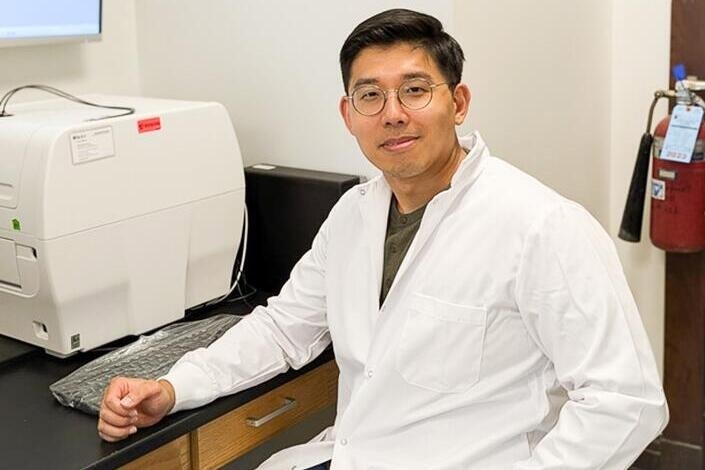Reviewed by Lexie CornerJul 31 2024
In a study published in Cell, researchers from the University of Illinois Urbana-Champaign provide an overview of the present and anticipated future states of organic nanozymes.
 Dong Hoon Lee. Image Credit: University of Illinois Urbana-Champaign
Dong Hoon Lee. Image Credit: University of Illinois Urbana-Champaign
Nanozymes are small, synthetic materials used in chemical engineering, biomedicine, and environmental applications. They are designed to imitate the catalytic characteristics of natural enzymes. However, due to their toxicity and high production costs, they are generally formed of inorganic materials, such as metal-based components, which renders them unsuitable for many uses.
Though they are still in the early phases of development, organic-based nanozymes have the potential for a wider range of applications, including food and agriculture.
Inorganic nanozymes have only been around since 2007, when researchers discovered that iron oxide nanoparticles could perform catalytic activity similar to natural enzymes like peroxidase. Their usage has rapidly advanced, but they have some major drawbacks. They are made from expensive ingredients, and they require a time-consuming, heavy engineering process for fabrication. They are potentially toxic to humans and the environment, and they are not naturally degradable, so they cause waste management issues.
Dong Hoon Lee, Study Lead Author and Doctoral Student, Department of Agricultural and Biological Engineering, University of Illinois Urbana-Champaign
ABE is part of the College of Agricultural, Consumer, and Environmental Sciences and the Grainger College of Engineering at the University of Illinois.
ABE Assistant Professor and Research Co-Author Mohammed Kamruzzaman stated that these problems caused organic nanozymes to arise a few years ago.
Organic nanozymes are cost-effective, non-toxic, and environmentally friendly. The fabrication process is less complicated, and they can be produced in a few hours, compared to several days for inorganic nanozymes. They are also much less expensive. The precious metals that are used for inorganic nanozymes cost around $400 per gram, while the organic materials and transition metal components cost less than 50 cents per gram. This makes them much more accessible for use in real-world applications outside of the laboratory.
Mohammed Kamruzzaman, Assistant Professor and Study Co-Author, Department of Agricultural and Biological Engineering, University of Illinois Urbana-Champaign
Additionally, some organic nanozymes are biodegradable and sustainable. Although at a far reduced level of toxicity, they still include a small amount of iron or copper, which is necessary to produce an “active site” for the enzyme-like catalytic action.
Based on the organic materials utilized to create polymers, biomacromolecules (primarily cellulose), organic chemicals, and biological components like DNA and peptides, the researchers identified four basic categories of organic nanozymes in the paper.
This offers other scientists basic knowledge by outlining the functionalities, components, chemical structure, and catalytic activity of each kind. It also shows how biomedicine is applied analogously to food, environment, and agriculture.
According to Kamruzzaman, 80 % of research is conducted in the biomedical field, which is where inorganic nanozymes first appeared. They are utilized, for instance, in biosensing, imaging, therapies, and diagnostic medicine.
Innate toxicity and its effects on cell viability in therapeutic applications, however, are a source of worry. Organic nanozymes can alleviate those concerns and extend applications to food and agriculture.
In earlier work, Kamruzzaman and Lee pioneered the application of organic nanozymes with an agricultural focus and integrated molecular sensing techniques to identify agricultural pesticides in food items.
The final objective is to develop a straightforward test kit that anybody can use anywhere, scan the findings with a phone app, and receive a color reading that represents the pesticide concentration in the food. Several other organic nanozymes derived from sustainable resources have also been released, and work is in progress on even more sophisticated molecular detecting systems.
Organic nanozymes have many advantages compared to inorganic nanozymes, but they are still in the early development stages, and there are many challenges that we need to overcome to apply them in the food and agriculture sector.
Mohammed Kamruzzaman, Assistant Professor and Study Co-Author, Department of Agricultural and Biological Engineering, University of Illinois Urbana-Champaign
One obstacle is a limited range of appropriate organic materials for production. Lipids and amino acids, according to the researchers, are intriguing building blocks for the following prototypes that may be essential to creating the next generation of nanozymes.
Journal Reference:
Lee, H. D., et al. (2024) Advancements in organic materials-based nanozymes for broader applications. Cell. doi.org/10.1016/j.trechm.2024.06.007.